1998 OPEL FRONTERA Electrical
[x] Cancel search: ElectricalPage 1243 of 6000

6E–126
ENGINE DRIVEABILITY AND EMISSIONS
DTC P0117 – ECT Sensor Low Voltage
StepActionVa l u e ( s )Ye sNo
1Was the “On-Board Diagnostic (OBD) System Check”
performed?
—Go to Step 2
Go to OBD
System
Check
21. Ignition “ON,” engine “OFF.”
2. Observe the “Eng Cool Temp” display on the Tech 2.
Is the “Eng Cool Temp” below the specified value?
139C
(282
F)Go to Step 4Go to Step 3
31. Ignition “ON,” engine “OFF.”
2. Review and record Tech 2 Failure Records data.
3. Operate the vehicle within Failure Records
conditions as noted.
4. Using a Tech 2, monitor “Specific DTC” info for DTC
P0117.
Does the Tech 2 indicate DTC P0117 failed this
ignition?
—Go to Step 4
Refer to
Diagnostic
Aids
41. Disconnect the ECT sensor electrical connector.
2. Observe the “Eng Cool Temp” display on the Tech 2.
Is the “Eng Cool Temp” at the specified value?
–39C
(–38
F)Go to Step 6Go to Step 5
51. Ignition “OFF.”
2. Disconnect the PCM and check the ECT signal
circuit for a short to ground or a short to the sensor
ground circuit.
3. If the ECT signal circuit is shorted. repair it as
necessary.
Was the ECT signal circuit shorted to ground?
—Verify repairGo to Step 7
6Replace the ECT sensor.
Is the action complete?
—Verify repair—
7Replace the PCM.
IMPORTANT:The replacement PCM must be
programmed. Refer to
UBS 98model year Immobilizer
Workshop Manual.
Is the action complete?—Verify repair—
Page 1245 of 6000
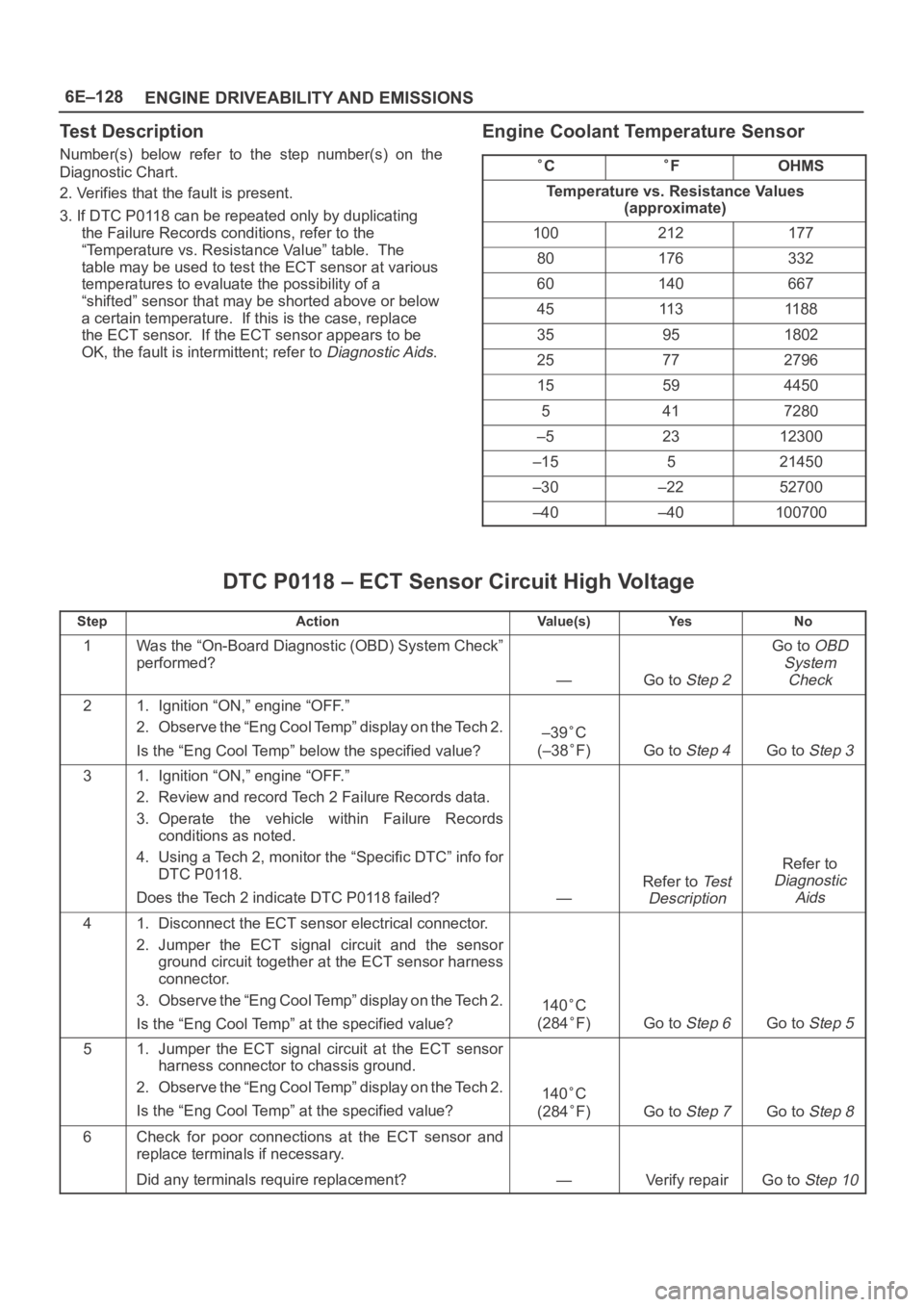
6E–128
ENGINE DRIVEABILITY AND EMISSIONS
Test Description
Number(s) below refer to the step number(s) on the
Diagnostic Chart.
2. Verifies that the fault is present.
3. If DTC P0118 can be repeated only by duplicating
the Failure Records conditions, refer to the
“Temperature vs. Resistance Value” table. The
table may be used to test the ECT sensor at various
temperatures to evaluate the possibility of a
“shifted” sensor that may be shorted above or below
a certain temperature. If this is the case, replace
the ECT sensor. If the ECT sensor appears to be
OK, the fault is intermittent; refer to
Diagnostic Aids.
Engine Coolant Temperature Sensor
CFOHMS
Temperature vs. Resistance Values
(approximate)
100212177
80176332
60140667
4511 31188
35951802
25772796
15594450
5417280
–52312300
–15521450
–30–2252700
–40–40100700
DTC P0118 – ECT Sensor Circuit High Voltage
StepActionVa l u e ( s )Ye sNo
1Was the “On-Board Diagnostic (OBD) System Check”
performed?
—Go to Step 2
Go to OBD
System
Check
21. Ignition “ON,” engine “OFF.”
2. Observe the “Eng Cool Temp” display on the Tech 2.
Is the “Eng Cool Temp” below the specified value?
–39C
(–38
F)Go to Step 4Go to Step 3
31. Ignition “ON,” engine “OFF.”
2. Review and record Tech 2 Failure Records data.
3. Operate the vehicle within Failure Records
conditions as noted.
4. Using a Tech 2, monitor the “Specific DTC” info for
DTC P0118.
Does the Tech 2 indicate DTC P0118 failed?
—
Refer to Te s t
Description
Refer to
Diagnostic
Aids
41. Disconnect the ECT sensor electrical connector.
2. Jumper the ECT signal circuit and the sensor
ground circuit together at the ECT sensor harness
connector.
3. Observe the “Eng Cool Temp” display on the Tech 2.
Is the “Eng Cool Temp” at the specified value?
140C
(284
F)Go to Step 6Go to Step 5
51. Jumper the ECT signal circuit at the ECT sensor
harness connector to chassis ground.
2. Observe the “Eng Cool Temp” display on the Tech 2.
Is the “Eng Cool Temp” at the specified value?
140C
(284
F)Go to Step 7Go to Step 8
6Check for poor connections at the ECT sensor and
replace terminals if necessary.
Did any terminals require replacement?
—Verify repairGo to Step 10
Page 1251 of 6000
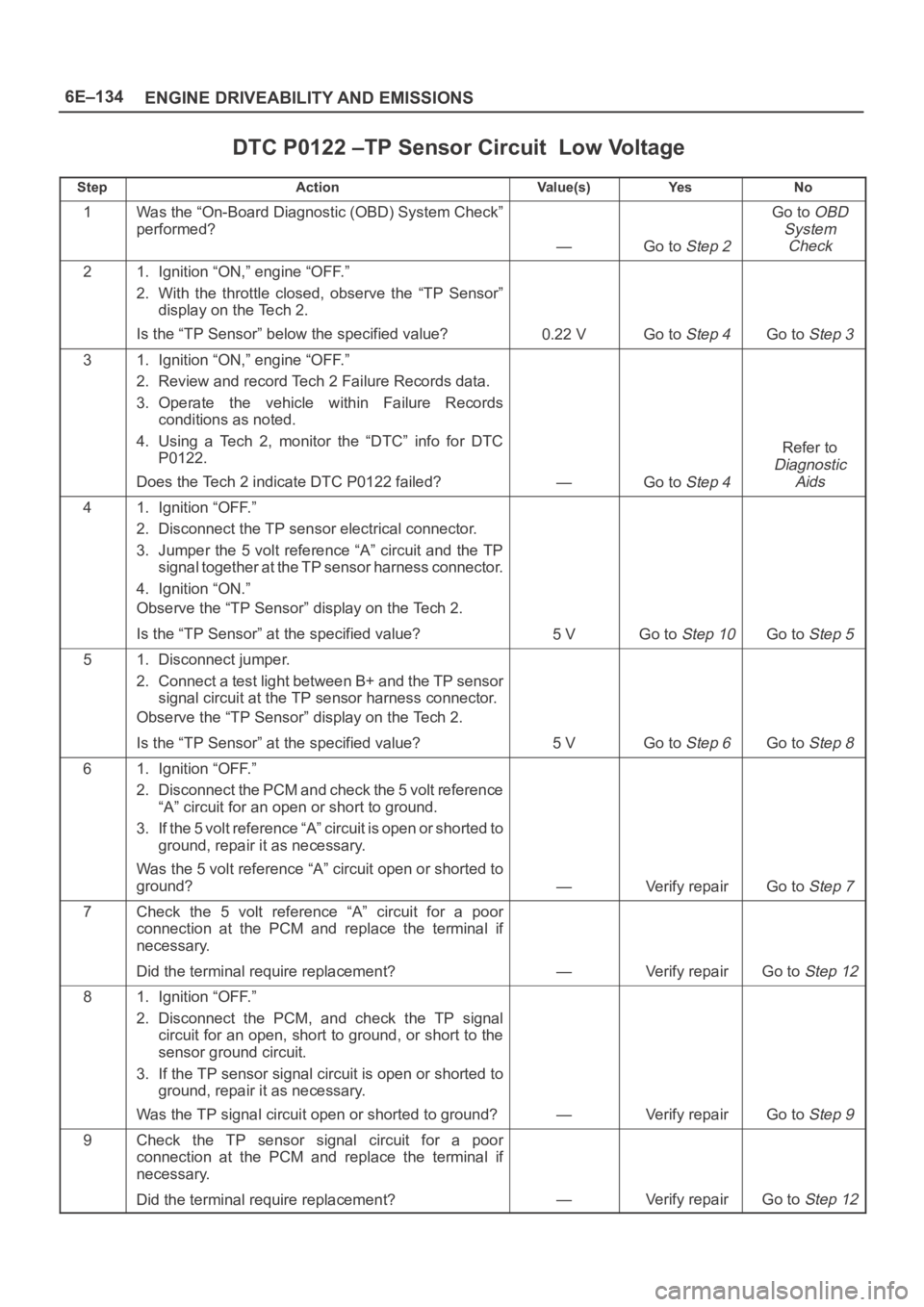
6E–134
ENGINE DRIVEABILITY AND EMISSIONS
DTC P0122 –TP Sensor Circuit Low Voltage
StepActionVa l u e ( s )Ye sNo
1Was the “On-Board Diagnostic (OBD) System Check”
performed?
—Go to Step 2
Go to OBD
System
Check
21. Ignition “ON,” engine “OFF.”
2. With the throttle closed, observe the “TP Sensor”
display on the Tech 2.
Is the “TP Sensor” below the specified value?
0.22 VGo to Step 4Go to Step 3
31. Ignition “ON,” engine “OFF.”
2. Review and record Tech 2 Failure Records data.
3. Operate the vehicle within Failure Records
conditions as noted.
4. Using a Tech 2, monitor the “DTC” info for DTC
P0122.
Does the Tech 2 indicate DTC P0122 failed?
—Go to Step 4
Refer to
Diagnostic
Aids
41. Ignition “OFF.”
2. Disconnect the TP sensor electrical connector.
3. Jumper the 5 volt reference “A” circuit and the TP
signal together at the TP sensor harness connector.
4. Ignition “ON.”
Observe the “TP Sensor” display on the Tech 2.
Is the “TP Sensor” at the specified value?
5 VGo to Step 10Go to Step 5
51. Disconnect jumper.
2. Connect a test light between B+ and the TP sensor
signal circuit at the TP sensor harness connector.
Observe the “TP Sensor” display on the Tech 2.
Is the “TP Sensor” at the specified value?
5 VGo to Step 6Go to Step 8
61. Ignition “OFF.”
2. Disconnect the PCM and check the 5 volt reference
“A” circuit for an open or short to ground.
3. If the 5 volt reference “A” circuit is open or shorted to
ground, repair it as necessary.
Was the 5 volt reference “A” circuit open or shorted to
ground?
—Verify repairGo to Step 7
7Check the 5 volt reference “A” circuit for a poor
connection at the PCM and replace the terminal if
necessary.
Did the terminal require replacement?
—Verify repairGo to Step 12
81. Ignition “OFF.”
2. Disconnect the PCM, and check the TP signal
circuit for an open, short to ground, or short to the
sensor ground circuit.
3. If the TP sensor signal circuit is open or shorted to
ground, repair it as necessary.
Was the TP signal circuit open or shorted to ground?
—Verify repairGo to Step 9
9Check the TP sensor signal circuit for a poor
connection at the PCM and replace the terminal if
necessary.
Did the terminal require replacement?
—Verify repairGo to Step 12
Page 1254 of 6000
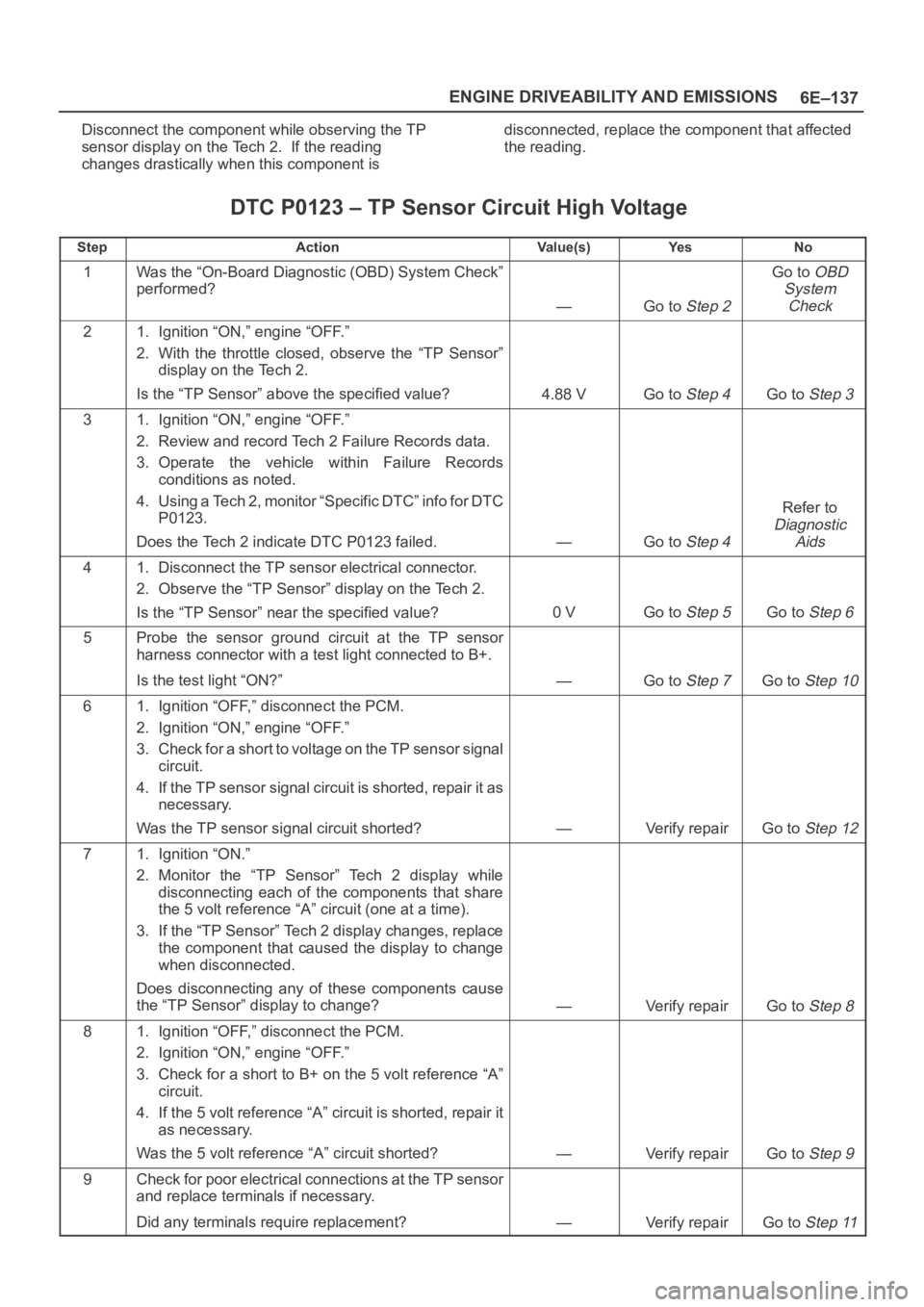
6E–137 ENGINE DRIVEABILITY AND EMISSIONS
Disconnect the component while observing the TP
sensor display on the Tech 2. If the reading
changes drastically when this component isdisconnected, replace the component that affected
the reading.
DTC P0123 – TP Sensor Circuit High Voltage
StepActionVa l u e ( s )Ye sNo
1Was the “On-Board Diagnostic (OBD) System Check”
performed?
—Go to Step 2
Go to OBD
System
Check
21. Ignition “ON,” engine “OFF.”
2. With the throttle closed, observe the “TP Sensor”
display on the Tech 2.
Is the “TP Sensor” above the specified value?
4.88 VGo to Step 4Go to Step 3
31. Ignition “ON,” engine “OFF.”
2. Review and record Tech 2 Failure Records data.
3. Operate the vehicle within Failure Records
conditions as noted.
4. Using a Tech 2, monitor “Specific DTC” info for DTC
P0123.
Does the Tech 2 indicate DTC P0123 failed.
—Go to Step 4
Refer to
Diagnostic
Aids
41. Disconnect the TP sensor electrical connector.
2. Observe the “TP Sensor” display on the Tech 2.
Is the “TP Sensor” near the specified value?
0 VGo to Step 5Go to Step 6
5Probe the sensor ground circuit at the TP sensor
harness connector with a test light connected to B+.
Is the test light “ON?”
—Go to Step 7Go to Step 10
61. Ignition “OFF,” disconnect the PCM.
2. Ignition “ON,” engine “OFF.”
3. Check for a short to voltage on the TP sensor signal
circuit.
4. If the TP sensor signal circuit is shorted, repair it as
necessary.
Was the TP sensor signal circuit shorted?
—Verify repairGo to Step 12
71. Ignition “ON.”
2. Monitor the “TP Sensor” Tech 2 display while
disconnecting each of the components that share
the 5 volt reference “A” circuit (one at a time).
3. If the “TP Sensor” Tech 2 display changes, replace
the component that caused the display to change
when disconnected.
Does disconnecting any of these components cause
the “TP Sensor” display to change?
—Verify repairGo to Step 8
81. Ignition “OFF,” disconnect the PCM.
2. Ignition “ON,” engine “OFF.”
3. Check for a short to B+ on the 5 volt reference “A”
circuit.
4. If the 5 volt reference “A” circuit is shorted, repair it
as necessary.
Was the 5 volt reference “A” circuit shorted?
—Verify repairGo to Step 9
9Check for poor electrical connections at the TP sensor
and replace terminals if necessary.
Did any terminals require replacement?
—Verify repairGo to Step 11
Page 1274 of 6000
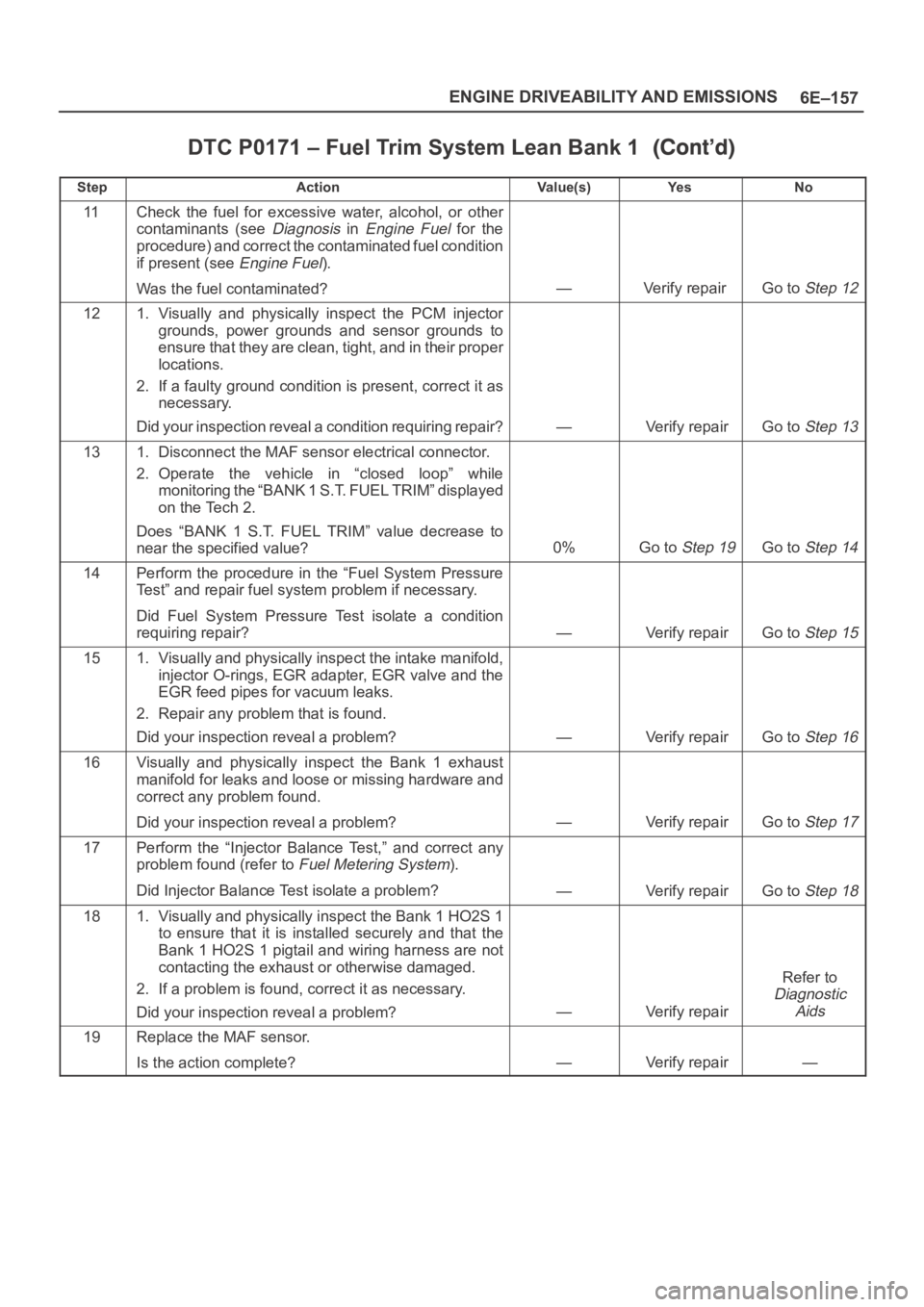
6E–157 ENGINE DRIVEABILITY AND EMISSIONS
DTC P0171 – Fuel Trim System Lean Bank 1
StepNo Ye s Va l u e ( s ) Action
11Check the fuel for excessive water, alcohol, or other
contaminants (see
Diagnosis in Engine Fuel for the
procedure) and correct the contaminated fuel condition
if present (see
Engine Fuel).
Was the fuel contaminated?
—Verify repair Go to Step 12
121. Visually and physically inspect the PCM injector
grounds, power grounds and sensor grounds to
ensure that they are clean, tight, and in their proper
locations.
2. If a faulty ground condition is present, correct it as
necessary.
Did your inspection reveal a condition requiring repair?
—Verify repairGo to Step 13
131. Disconnect the MAF sensor electrical connector.
2. Operate the vehicle in “closed loop” while
monitoring the “BANK 1 S.T. FUEL TRIM” displayed
on the Tech 2.
Does “BANK 1 S.T. FUEL TRIM” value decrease to
near the specified value?
0%Go to Step 19Go to Step 14
14Perform the procedure in the “Fuel System Pressure
Test” and repair fuel system problem if necessary.
Did Fuel System Pressure Test isolate a condition
requiring repair?
—Verify repairGo to Step 15
151. Visually and physically inspect the intake manifold,
injector O-rings, EGR adapter, EGR valve and the
EGR feed pipes for vacuum leaks.
2. Repair any problem that is found.
Did your inspection reveal a problem?
—Verify repairGo to Step 16
16Visually and physically inspect the Bank 1 exhaust
manifold for leaks and loose or missing hardware and
correct any problem found.
Did your inspection reveal a problem?
—Verify repairGo to Step 17
17Perform the “Injector Balance Test,” and correct any
problem found (refer to
Fuel Metering System).
Did Injector Balance Test isolate a problem?
—Verify repairGo to Step 18
181. Visually and physically inspect the Bank 1 HO2S 1
to ensure that it is installed securely and that the
Bank 1 HO2S 1 pigtail and wiring harness are not
contacting the exhaust or otherwise damaged.
2. If a problem is found, correct it as necessary.
Did your inspection reveal a problem?
—Verify repair
Refer to
Diagnostic
Aids
19Replace the MAF sensor.
Is the action complete?
—Verify repair—
Page 1278 of 6000

6E–161 ENGINE DRIVEABILITY AND EMISSIONS
DTC P0172 – Fuel Trim System Rich Bank 1
StepNo Ye s Va l u e ( s ) Action
111. Disconnect the vacuum hose from the fuel pressure
regulator and inspect the hose for the presence of
fuel.
2. If fuel is present in the vacuum hose, replace the
fuel pressure regulator (refer to
Fuel Metering
System
).
Did the fuel pressure regulator require replacement?
—Verify repairGo to Step 12
12Ignition “ON,” engine “OFF,” monitor the TP Angle
display on the Tech 2 while slowly depressing the
accelerator pedal.
Does the TP Angle display increase steadily and
evenly from minimum value at closed throttle to
maximum value at wide-open throttle?
Minimum 0%
Maximum
100%
Go to Step 13Go to Step 18
131. Disconnect the MAF sensor electrical connector.
2. Operate the vehicle in “closed loop” while
monitoring the “BANK 1 L.T. FUEL TRIM” and
“BANK 1 S. T. FUEL TRIM” display on the Tech 2.
Did both values change to near the specified value?
0%Go to Step 19Go to Step 14
141. Perform “Fuel System Pressure Test.”
2. If Fuel System Pressure Test isolates a problem,
repair as necessary (refer to
Engine Fuel or Fuel
Metering System
).
Did the Fuel System Pressure Test isolate a problem
requiring repair?
—Verify repairGo to Step 16
15Replace the PCM.
IMPORTANT:The replacement PCM must be
programmed. Refer to
UBS 98model year Immobilizer
Workshop Manual.
Is the action complete?—Verify repair—
161. Perform the “Injector Balance Test.”
2. If Injector Balance Test isolates a problem, repair as
necessary (refer to
Fuel Metering System).
Did the Injector Balance Test isolate a problem
requiring repair?
—Verify repair Go to Step 17
171. Remove and visually/physically inspect the Bank 1
HO2S 1 for silicon contamination. This will be
indicated by a powdery white deposit on the portion
of the HO2S that is exposed to the exhaust stream.
2. If contamination is evident on the Bank 1 HO2S 1,
replace the contaminated sensors.
Did the sensor require replacement?
—Verify repair
Refer to
Diagnostic
Aids
181. Check the TP sensor mounting screws and tighten
or replace them as necessary if they are loose or
missing.
2. If the screws are OK, replace the TP sensor.
Is the action complete?
—Verify repair—
19Replace the MAF sensor.
Is the action complete?
—Verify repair—
Page 1282 of 6000

6E–165 ENGINE DRIVEABILITY AND EMISSIONS
DTC P0174 – Fuel Trim System Lean Bank 2
StepNo Ye s Va l u e ( s ) Action
101. Visually and physically inspect the throttle body,
intake manifold, EGR valve and the EGR feed pipe
for vacuum leaks.
2. Repair any vacuum leaks as necessary.
Did your inspection reveal a vacuum leak?
—Verify repairGo to Step 11
11Check the fuel for excessive water, alcohol, or other
contaminants (see
Diagnosis in Engine Fuel for
procedure) and correct the contaminated fuel condition
is present (see
Engine Fuel).
Was the fuel contaminated?
—Verify repairGo to Step 12
121. Visually and physically inspect the PCM injector
grounds, power grounds and sensor grounds to
ensure that they are clean, tight, and in their proper
locations.
2. If a faulty ground condition is present, correct it as
necessary.
Did your inspection reveal a condition requiring repair?
—Verify repairGo to Step 13
131. Disconnect the MAF sensor electrical connector.
2. Operate the vehicle in “closed loop” while
monitoring the “BANK 1 S.T. FUEL TRIM” displayed
on the Tech 2.
Does the “BANK 1 S.T. FUEL TRIM” value decrease to
near the specified value?
0%Go to Step 19Go to Step 14
14Perform the procedure in the ”Fuel System Pressure
Test” and repair fuel system problem if necessary.
Did the Fuel System Pressure Test isolate a condition
requiring repair?
—Verify repairGo to Step 15
151. Visually and physically inspect the intake manifold,
injector O-rings, EGR adapter, EGR valve and the
EGR feed pipes for vacuum leaks.
2. Repair any problem that is found.
Did your inspection reveal a problem?
—Verify repairGo to Step 16
16Visually and physically inspect the Bank 2 exhaust
manifold for leaks and loose or missing hardware and
correct any problem found.
Did your inspection reveal a problem?
—Verify repairGo to Step 17
17Perform the “Injector Balance Test,” and correct any
problem found (refer to
Fuel Metering System).
Did the Injector Balance Test isolate a problem?
—Verify repair Go to Step 18
181. Visually and physically inspect the Bank 2 HO2S 1
to ensure that it is installed securely and that the
Bank 2 HO2S 1 pigtail and wiring harness are not
contacting the exhaust or otherwise damaged.
2. If a problem is found, correct it as necessary.
Did your inspection reveal a problem?
—Verify repair
Refer to
Diagnostic
Aids
19Replace the MAF sensor.
Is the action complete?
—Verify repair—
Page 1286 of 6000
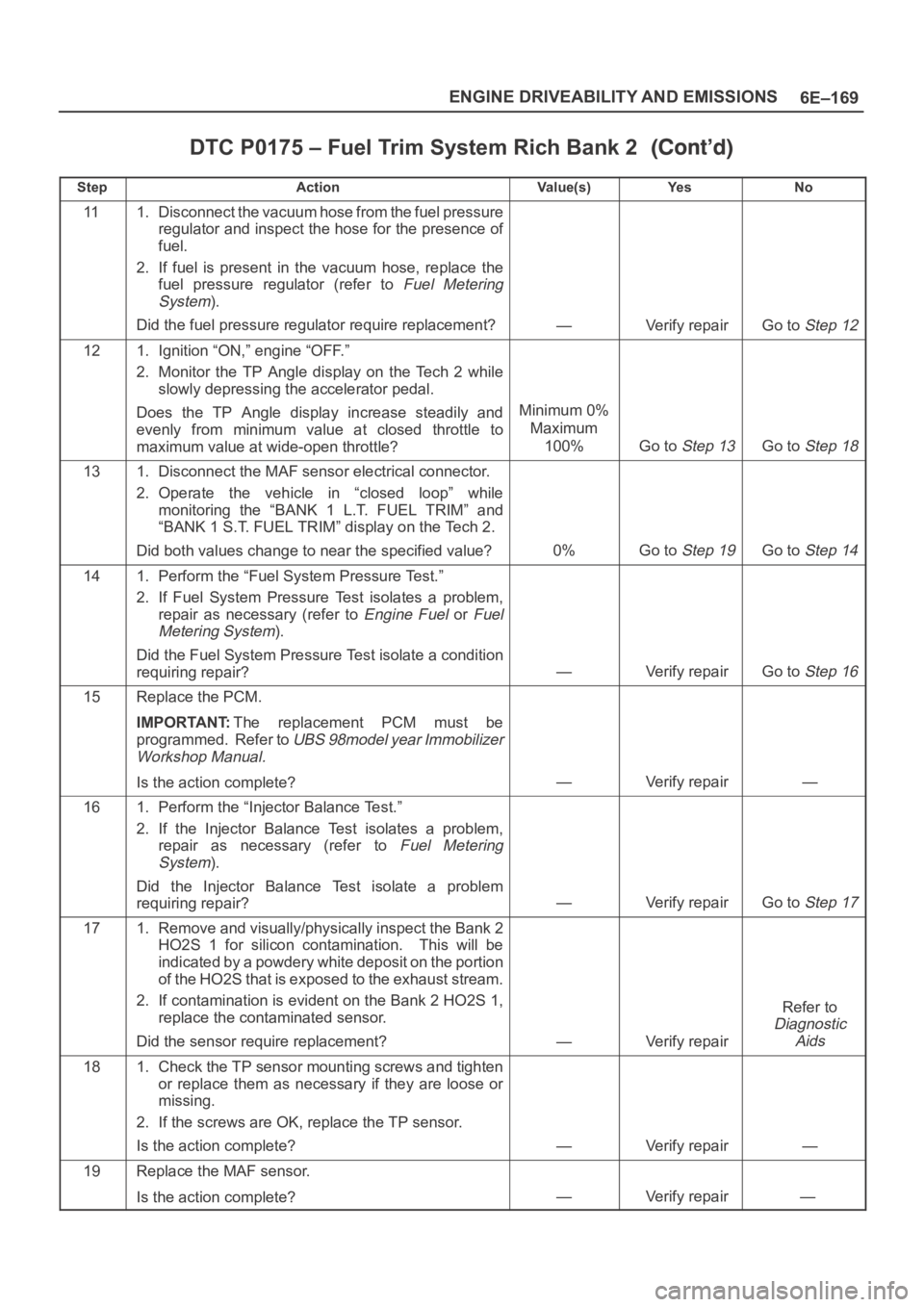
6E–169 ENGINE DRIVEABILITY AND EMISSIONS
DTC P0175 – Fuel Trim System Rich Bank 2
StepNo Ye s Va l u e ( s ) Action
111. Disconnect the vacuum hose from the fuel pressure
regulator and inspect the hose for the presence of
fuel.
2. If fuel is present in the vacuum hose, replace the
fuel pressure regulator (refer to
Fuel Metering
System
).
Did the fuel pressure regulator require replacement?
—Verify repairGo to Step 12
121. Ignition “ON,” engine “OFF.”
2. Monitor the TP Angle display on the Tech 2 while
slowly depressing the accelerator pedal.
Does the TP Angle display increase steadily and
evenly from minimum value at closed throttle to
maximum value at wide-open throttle?
Minimum 0%
Maximum
100%
Go to Step 13Go to Step 18
131. Disconnect the MAF sensor electrical connector.
2. Operate the vehicle in “closed loop” while
monitoring the “BANK 1 L.T. FUEL TRIM” and
“BANK 1 S.T. FUEL TRIM” display on the Tech 2.
Did both values change to near the specified value?
0%Go to Step 19Go to Step 14
141. Perform the “Fuel System Pressure Test.”
2. If Fuel System Pressure Test isolates a problem,
repair as necessary (refer to
Engine Fuel or Fuel
Metering System
).
Did the Fuel System Pressure Test isolate a condition
requiring repair?
—Verify repairGo to Step 16
15Replace the PCM.
IMPORTANT:The replacement PCM must be
programmed. Refer to
UBS 98model year Immobilizer
Workshop Manual.
Is the action complete?—Verify repair—
161. Perform the “Injector Balance Test.”
2. If the Injector Balance Test isolates a problem,
repair as necessary (refer to
Fuel Metering
System
).
Did the Injector Balance Test isolate a problem
requiring repair?
—Verify repairGo to Step 17
171. Remove and visually/physically inspect the Bank 2
HO2S 1 for silicon contamination. This will be
indicated by a powdery white deposit on the portion
of the HO2S that is exposed to the exhaust stream.
2. If contamination is evident on the Bank 2 HO2S 1,
replace the contaminated sensor.
Did the sensor require replacement?
—Verify repair
Refer to
Diagnostic
Aids
181. Check the TP sensor mounting screws and tighten
or replace them as necessary if they are loose or
missing.
2. If the screws are OK, replace the TP sensor.
Is the action complete?
—Verify repair—
19Replace the MAF sensor.
Is the action complete?
—Verify repair—